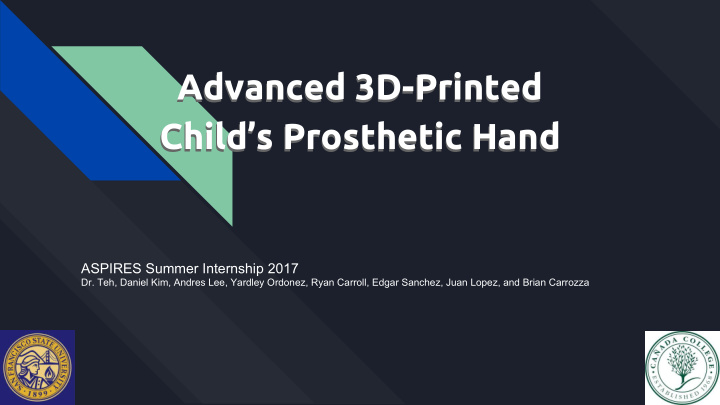



Advanced 3D-Printed Advanced 3D-Printed Child’s Prosthetic Hand Child’s Prosthetic Hand ASPIRES Summer Internship 2017 Dr. Teh, Daniel Kim, Andres Lee, Yardley Ordonez, Ryan Carroll, Edgar Sanchez, Juan Lopez, and Brian Carrozza
Overview 1. Motivation 2. Background 3. Problem Statement 4. Solution 5. Design Details 6. Testing 7. Results and Analysis 8. Bill of Materials (BOM) 9. Summary 10. Sources
Background & Motivation ● Most pediatric amputations occur in ages of 0-5 yrs ● 4 out of 10,000 births suffer from upper limb deficiency ● Commercially available prosthetics cost upwards of $4,000 ● Child growth requires new prosthetics ● Limited motion through single wrist actuation
Solutions ● Low cost PLA ● Mechanisms: IMF & GL ● Abducted Thumb ● Silicon fingertips ● Open Source
Final Design Details Abducted Thumb ● Grip Lock ● Finger Control ●
Basic Operation
Abducted vs. Adducted Thumb Adducted Abducted
Individual Finger Control (IFC) iihbfghnfgnfgnf
Individual Finger Control (IFC)
Grip Lock
Grip Lock
Grip Lock
Testing ● Grip precision Test ○ Test: Pick up/move a stack of washers ● Button Selection Precision Test ○ Test: Press buttons in predetermined pattern ● Grip force Test ○ Test: Weight added to rod
Results and Analysis ● Stacking Washers Test: ○ Modified prosthetic: 9.4 of 15 washers stacked ○ Standard prosthetic: 9.2 of 15 washers stacked ○ Overall advantage: Negligible ○ Observations: Using two fingers reduced likelihood of stacks being knocked over. ● Patterned Button Pressing Test: ○ Modified prosthetic: 97.6% accurate ○ Standard Prosthetic: 30.7% accurate ○ Overall advantage: Significant [66.9% improvement] ○ Observations: Unused, engaged fingers of standard prosthetic caused numerous unintended button presses. ● Weighted Rod Test: ○ Modified prosthetic: 1538.8g (avg. weight held when slippage began) ○ Standard Prosthetic: 568g (avg. weight held when slippage began) ○ Overall advantage: Significant [2.7x] ○ Observations: gel fingertips caused rod to slip slowly, while bare PLA fingers released quickly.
Bill of Materials Item Quantity Price PLA 1 roll (~111m) $20.00 Braided fishing wire 1 roll (137m) $10.72 Nylon String 1 roll (~91m) $7.79 Springs 12-pk $ 5.43 Sheet metal screws 16-pk $ 1.18 #6 x 3/8 Total Cost: $50.12
Estimated Cost to Produce our Prosthetic Hand - Breakdown of Materials Used Material Used Quantity Used Unit Cost Total Price of Material Used PLA ~17.2m $0.075/m $3.87 Braided fishing wire ~3.66m $0.078/m $0.29 Nylon String ~1.83m $0.086/m $0.16 Sheet metal screws 5 screws $0.074/screw $0.37 springs 5 springs $0.452/spring $2.26 Estimated Total Cost to Produce our Prosthetic Hand: $6.95
Future Work ● Switchless individual control ● Streamline grip lock interface ● Silicon to replicate skin ● Implement more aesthetic design ● Improve Comfort
Summary ● Kids with Partial Hands ● Choice between Limited Functionality or High Costs ● Design mechanisms for higher functioning body powered prosthetics ● Develop tests to determine effectiveness of modifications
Sources 1. C. (Ed.). (2016, November 14). Birth Defects. Retrieved July 26, 2017, from https://www.cdc.gov/ncbddd/birthdefects/ul-limbreductiondefects.html 2. Borne, A., Porter, A., Recicar, J., Maxson, T., & Montgomery, C. (2017). Pediatric Traumatic Amputations in the United States. Journal of Pediatric Orthopaedics, 37 (2). doi:10.1097/bpo.0000000000000693 3. Carey, S. L., Lura, D. J., & Highsmith, M. J. (2015). Differences in myoelectric and body-powered upper-limb prostheses: Systematic literature review. Journal of Rehabilitation Research and Development, 52 (3), 247-262. doi:10.1682/jrrd.2014.08.0192 4. Resnik, L., Meucci, M. R., Lieberman-Klinger, S., Fantini, C., Kelty, D. L., Disla, R., & Sasson, N. (2012). Advanced Upper Limb Prosthetic Devices: Implications for Upper Limb Prosthetic Rehabilitation. Archives of Physical Medicine and Rehabilitation, 93 (4), 710-717. doi:10.1016/j.apmr.2011.11.010
Questions ?
Recommend
More recommend